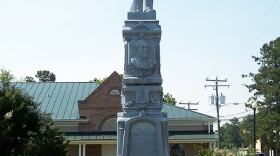Note: this segment is a rebroadcast from June 20, 2017.
In May 1862, Robert Smalls became a Union hero overnight when he stole a Confederate steamer from the Charleston harbor. Smalls had been enslaved his whole life and decided to free himself and his family by stealing the Planter and piloting it to the Union fleet outside Charleston, South Carolina.
Smalls would go on to be a public speaker across the North during the Civil War. After the war, he moved back to his hometown of Beaufort, S.C. and became a business owner and eventually a U.S. congressman. In her new book ŌĆ£ŌĆØ (St. MartinŌĆÖs Press/2017), writer Cate Lineberry details SmallsŌĆÖ courageous journey and the culture surrounding Charleston and the Confederacy at the time of his escape.
INTERVIEW HIGHLIGHTS
On SmallsŌĆÖ upbringing in Beaufort, S.C.
: He is born in 1839 in Beaufort. His mother was a house slave for the McKee family. So he grew up in a very unique position in the fact that she had been taken from the plantation as a child and was familiar with Gullah which was a local Creole language that they speak. But Robert was also in the house growing up and was aware of a lot of things around him that a lot of slaves were not privy too ŌĆ” When he was 12 years old, his owner Henry McKee decided that it would be best for Smalls to move to Charleston. There he would hire Smalls out for services. Everything that Smalls earned, that money went to McKee.On SmallsŌĆÖ determination to find freedom: Robert Smalls was an incredibly resourceful and brilliant guy. From the get-go he was looking for ways to insure his own freedom. He married, at 17, a much older woman who was in her 30s. They eventually had two children. His greatest fear at that point was for them to be separated which frequently happened for enslaved families. At that point with children in his care, he started looking for a way to escape.
On how he hatched his plan to steal the steamer and escape: The captain who was relatively new to the ship wore a wide-brimmed straw hat. One day the crew was joking ŌĆō IŌĆÖm sure it was when the white officers were not around ŌĆō and one put the hat on Smalls and they joked that he looked like the captain because both Smalls and the captain were very stocky. A lightbulb went off for Smalls at that moment. He started thinking, ŌĆśYou know what, maybe I can impersonate the captain and get this ship out of the harbor.ŌĆÖ It was an extraordinary idea. It was dangerous but it was brilliant.
On getting past Fort Sumter in the Charleston harbor: It was inconceivable that they actually did it in many ways. There were several fortifications around the Charleston harbor as well as batteries surrounding the harbor. If anyone were to suspect slaves were stealing a ship they would immediately attack ŌĆ” I canŌĆÖt imagine what they went through. It was only 10 miles but IŌĆÖm sure it was an excruciating 10 mile trip ... Even as Smalls passed Fort Sumter, he had to give a certain code that he knew from reconnaissance trips theyŌĆÖd taken on the Planter. The guy on duty said, ŌĆśHave a great time. Good luck,ŌĆÖ and Smalls stayed in character and waited. They all sat there patiently waiting to see if they were going to figure out and the Confederates were going to shoot or not.
On approaching the Union fleet once Smalls was out of the harbor: He was smart enough to know they would immediately have to signal. They took down the state flag, the South Carolina state flag, and they hoisted a white bed sheet as a flag. But the Union officer on board the Onward, which was the ship they were approaching, did not see it at first. He got all his men ready to fire, the guns were up ready to go and at the last second he saw the white bed sheet and told them not to fire. It was a very close call.
On SmallsŌĆÖ return to Beaufort after the Civil War: At the time many former enslaved men and women were desperate for their own place to live. But not only did Robert Smalls find a great place to live, he ended up buying the home he and his mother had once been enslaved in. ItŌĆÖs a beautiful, large white house that still stands in Beaufort today. There were tax sales because when the Union arrived in Port Royal in the Beaufort area in 1861 the whites fled and their homes sat abandoned. The U.S. government started selling their homes off and thatŌĆÖs how Robert was able to buy one.








